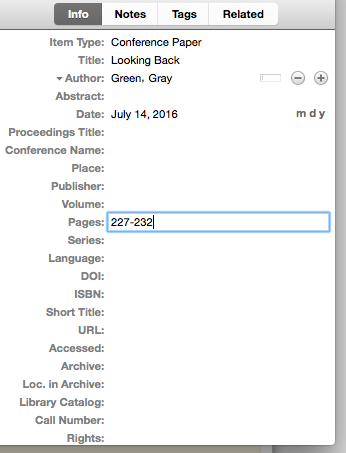
This page will teach you how to save the following types of sources in your Zotero library:
It will also tell you how to create a handmade citation from scratch for any type of source you may wish to add.
While one of Zotero's strengths is its ability to save bibliographic data for you, you can also choose to create a bibliographic citation by hand for any source you wish.
To do this:
1. Click on the green plus icon: 
2. Select the type of source you wish to save. Note that under "More" there is a large list of item types, including Conference Paper, Film, Radio Broadcast, and more.

3. On the right side of your Zotero library, you will see editable fields. Type all information that you wish to save here. At a minimum, save those fields required by the citation style you will be using. You can also add any notes that you wish to save with this source, or any additional tags that will help you find it while writing your paper or compiling your bibliography.
4. The item will be added to your Zotero library and can be retrieved using any of the field or tags you associated with it.
Important Note: Zotero will save new items to the collection selected in your Zotero library at the time of import. For most flexibility, we recommend using "My Library" as your default collection, and then using the drag-and-drop method to move particular items to their desired locations.
Once downloaded and installed, Zotero works through simple icons found in your web browser. Each icon means something different:
 =folder of citations (this means Zotero sensed more than one item on the page)
=folder of citations (this means Zotero sensed more than one item on the page)
 = book citation
= book citation
 = article citation
= article citation
 = newspaper article
= newspaper article
 = web page
= web page
These are the most common types to recognize, but you will see others. Look at your web browser, search for a web page or book from the library catalog, and then look for this icon. In the Chrome extension, it appears to the right of the web browser address bar:

To save a source, click on the icon that you see by the web browser. You will know you were successful when you see a confirmation message on the bottom right side of your screen, like this:

Note: the Luther Seminary catalog system shows multiple resources on each page. Zotero picks up on these options and presents to you a folder of sources found on the page. Select each item that you wish to add to your Zotero library by clicking next to the title, then clicking "OK":
 You can use "select all" to save everything on that page, or "deselect all" to un-mark all items.
You can use "select all" to save everything on that page, or "deselect all" to un-mark all items.
Zotero works well with library databases like the ATLA Religion Database and JSTOR. In addition to saving citations, it can also save a PDF of a full-text article found in the searched database. This is quite handy for keeping sources together and being able to reference articles as needed. Here's how to save article citations and associated PDFs:
1. The option to save PDFs is a default selection when setting up Zotero. To make sure you have this feature turned on, go to General tab of your Zotero program and look under the "Miscellaneous" heading. Make sure that the line reading "Automatically attach associated PDFs and other files when saving items" is selected.
2. Run your search of choice in the ATLA Religion Database or another database with full-text access. You will see the folder option in the top right side of your screen next to your web address brower. Click on it to select the items of interest. You can also choose to navigate through each record and select items one by one.
3. The items selected will be downloaded to your Zotero library with any associated PDFs attached underneath the bibliographic record. Click on the small arrow button next to a record in your Zotero library to access the connected PDF.
Zotero "senses" the information contained on the back end of web pages, called metadata, and uses this to save information from a site. Just click on the icon next to the web browser window to save. If you have opted for Zotero to save screenshots, a screenshot of the web page will be saved along with the citation information. This is quite handy for academic purposes, since you can verify what a dynamic web page looked like on a particular day.
Note: Because Zotero's information is only as good as that provided by the web page, it is always worth checking the information saved automatically by Zotero and adding fields manually as needed.